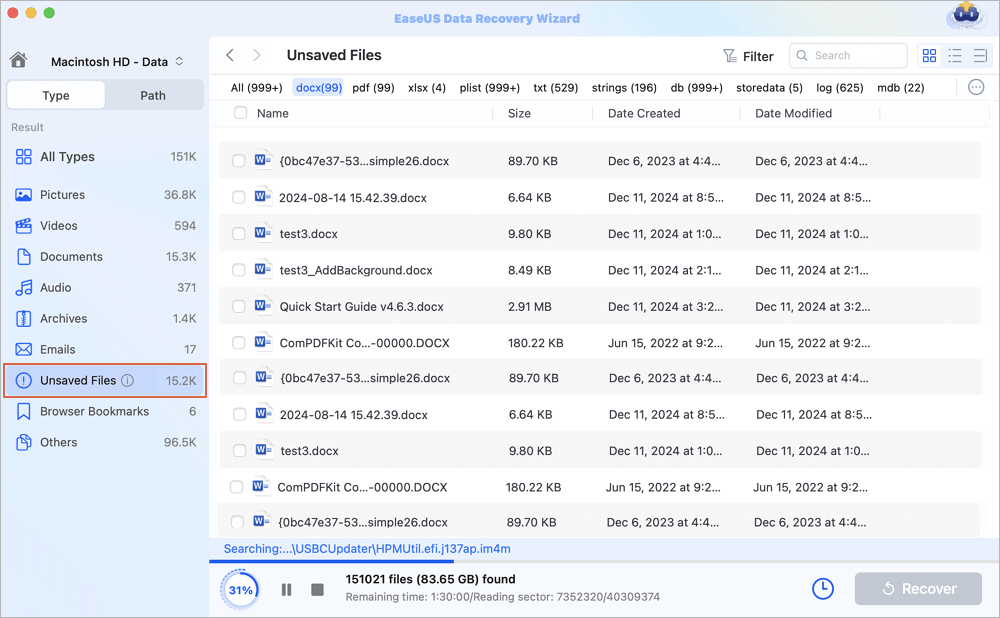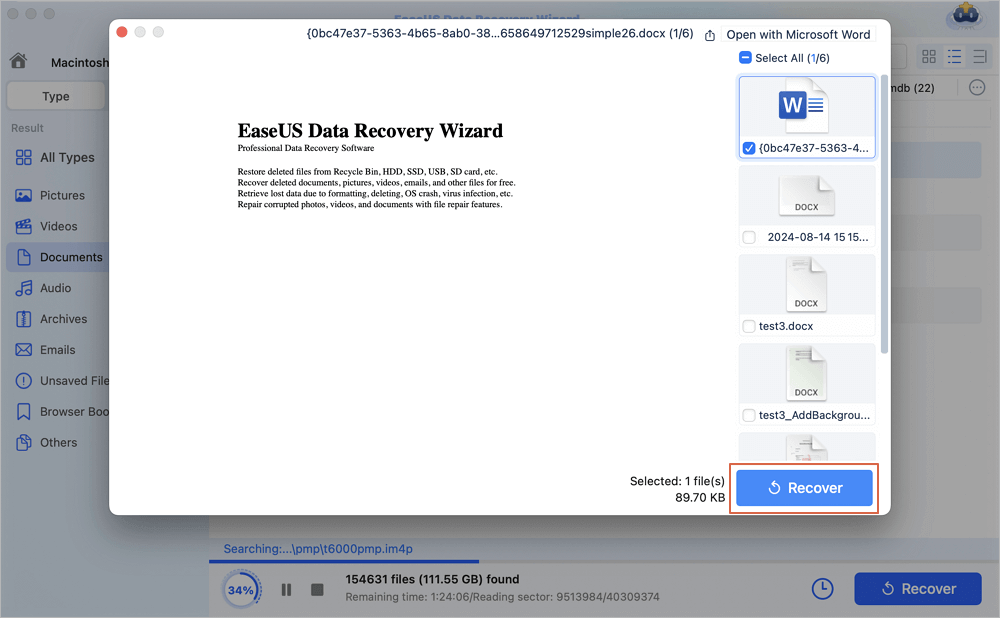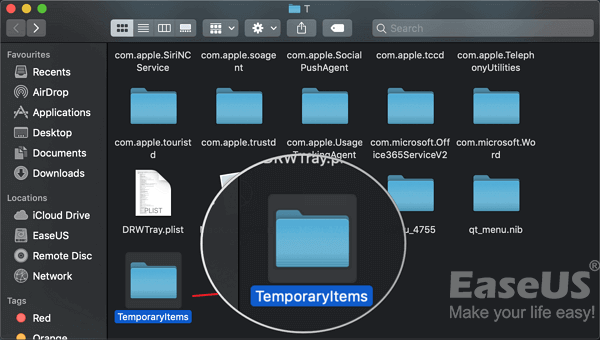What is Word temporary files Mac? A temporary Word file stores a copy of an unsaved Word document you are working on on your Mac. It is generated every time you open a document. You may wonder what the Word temporary files Mac does. The primary usage of temporary files of Word is to recover unsaved Word documents Mac.
By default, Word saved the temporary files in the TMP folder on Mac. In this article, we will introduce where the Word temporary files are located on Mac and how to use the temporary files to recover unsaved documents in Word.
Recover Unsaved Word Documents with File Recovery Software
If the above methods can't solve your problem, it's suggested that you use professional file recovery software, EaseUS Data Recovery Wizard for Mac. It supports file recovery from sudden crashes, accidental deletions, and unsaved situations.
Accidentally pressed Don't Save on Word Mac? With the EaseUS data recovery Mac software, you can recover permanently deleted files Mac, including Word, Excel, and PowerPoint files. With its easy-to-use interface, you can recover unsaved Word documents with a few clicks.
You Can Trust EaseUS Data Recovery Software
EaseUS Data Recovery Wizard has acquired an extensive technical base in data recovery and trusted by billions of users since 2005. Check out reviews on Trustpilot.
Check out the following steps:
Step 1. Select the disk
Launch EaseUS Data Recovery Wizard for Mac, hover the mouse over the device where you lost an unsaved file, and click "Search for lost files".

Step 2. Choose unsaved documents
After the scan, click "Type", and expand "Unsaved Documents". Click the exact file type - Word, Excel, Powerpoint, Keynote, Pages, or Numbers you lost without saving.

Step 3. Preview and recover unsaved files
Double-click to preview your unsaved file, select the right version and click "Recover" to save the file to another secure location on Mac.

The video below can help you better understand the full steps of unsaved Word recovery on Mac and the Word temp file location.
- 00:29 Method 1. Recover Unsaved Word Document Mac with AutoRecover
- 01:28 Method 2. Recover Unsaved Word from Temp Folder
- 01:54 Method 3. Apply Time Machine to Recover Unsaved Word on Mac
- 02:22 Method 4. Apply Unsaved Word Document Recovery Software

Share this article on social media to help others learn how to recover unsaved Word documents with Word temporary files Mac.
How to Find Word Temporary Files Mac [2 Proven Methods]
When you are working on Word documents, suddenly the Word keeps crashes Mac, and you have to force quit the Word application or restart your Mac. As a result, you lose the newest change on the Word document, and even worse, the Word document disappears.
Where are ~ *.docx files stored on my Mac, and why does Word change a document name to this temporary file format while I am making modifications to a Word document? from Apple Community
In this case, like the one reported on the Apple community, you may face the same situation: the Word document changes to a temporary file format. What can you do to retrieve the unsaved Word document?
1️⃣Find Word Temporary Files Mac via Terminal
The Terminal is a powerful built-in program on your Mac, and one of its features is to quickly access the location folder you want. Follow the steps below to find Word temporary files on Mac:
Step 1. Open Terminal in "Applications > Utilities".
Step 2. Enter open $TMPDIR in Terminal to directly open the TMP folder, which stores Word temporary files.
Step 3. Find and open the "TemporaryItems" folder.

Step 4. Select the desired unsaved Word document and open it using Microsoft Word.
If you want to retrieve the unsaved Word documents, you can click "Save As" and save them to a new location.
2️⃣Find Word Temporary Files Mac using Finder
Apart from using Terminal, you can also use the Mac Finder to locate Word temporary files. Follow the steps below to search for the Word temporary files on Mac:
Step 1. Click "File > New Tab" to open a tab to explore the storage of your MacBook. Or press "Command + N" to open Mac Finder.

Step 2. Type the file name you want to find in the search box and press "Enter" to continue.
Here are 2 practical methods to recover unsaved Word documents: using Word temporary files and using file recovery software. Both of them can recover unsaved Word documents Mac without AntoRecovery.
Recover Unsaved Documents Using Word Temporary Files
As we mentioned, one of the main features of Word temporary files is to recover unsaved Word documents. Once you find the Word temporary files using Terminal or Finder, you should open and save them. Check out the following steps:
Step 1. Find the Word temporary files of the unsaved Word documents using Terminal or Finder on Mac.
Step 2. Select the Word temporary files in the TemporaryItems folder.
Step 3. Open the Word temporary files in Microsoft Word and go to "File > Save As" to save the unsaved Word documents to a safe location.
You can recover the unsaved Word/Excel files from the crashed Office 2016 with temporary files on your MacBook; check out this article.

Recover Unsaved Word/Excel Files in Crashed Office 2016 on Mac
This article discusses 4 effective methods to recover unsaved Word and Excel files in crashed Office 2016 on Mac. Read more >>
Conclusion
This article introduces how to find Word temporary files on Mac and how to recover unsaved Word documents with Word temporary files. In addition, we also provide 2 practical alternatives to recover unsaved Word documents: The Autorecovery feature in the Word application and EaseUS Data Recovery Wizard for Mac.
Word Temporary Files Mac FAQs
Here are questions people frequently ask related to Word temporary files Mac:
1. Where are Word temporary files on Mac?
Word temporary files are stored in the TMP folder on Mac; check out the steps:
Step 1. Open Terminal in "Applications > Utilities".
Step 2. Enter open $TMPDIR in Terminal to directly open the TMP folder, which stores Word temporary files.
Step 3. Find and open the "TemporaryItems" folder.
2. How do I recover unsaved Word documents on Mac from the TMP folder?
You should follow the steps below to recover unsaved Word documents from the TMP folder:
Step 1. Open "Terminal" and enter open $TMPDIR to go to the TMP folder.
Step 2. Find and open the desired Word documents in the TMP folder using Microsoft Word.
Step 3. Go to "File > Save As" to save the documents in a new location.
3. Can I recover an unsaved Word document on Mac without AutoRecovery?
You can recover an unsaved Word document without AutoRecovery, such as using the professional and trusted EaseUS Data Recovery Wizard for Mac, recovering from the Recover Items folder, and restoring from Time Machine backups.
Was This Page Helpful?
Finley is interested in reading and writing articles about technical knowledge. Her articles mainly focus on file repair and data recovery.
Brithny is a technology enthusiast, aiming to make readers' tech lives easy and enjoyable. She loves exploring new technologies and writing technical how-to tips. In her spare time, she loves sharing things about her game experience on Facebook or Twitter.
-
EaseUS Data Recovery Wizard is a powerful system recovery software, designed to enable you to recover files you’ve deleted accidentally, potentially lost to malware or an entire hard drive partition.
Read More -
EaseUS Data Recovery Wizard is the best we have seen. It's far from perfect, partly because today's advanced disk technology makes data-recovery more difficult than it was with the simpler technology of the past.
Read More -
EaseUS Data Recovery Wizard Pro has a reputation as one of the best data recovery software programs on the market. It comes with a selection of advanced features, including partition recovery, formatted drive restoration, and corrupted file repair.
Read More
Related Articles
-
Official Ways to Recover Deleted Home Folder on a Mac [Step-by-Step Tutorial]
![author icon]() Brithny/Dec 12, 2025
Brithny/Dec 12, 2025 -
Top 11 Tools to Recover Deleted Partitions on Mac
![author icon]() Daisy/Dec 15, 2025
Daisy/Dec 15, 2025 -
How to Delete BootCamp Partition and Recover Space on Mac
![author icon]() Jaden/Dec 12, 2025
Jaden/Dec 12, 2025 -
Mac Downloads Folder Empty - 4 Solutions to Fix It Without Data Loss
![author icon]() Brithny/Dec 12, 2025
Brithny/Dec 12, 2025